Did you know growing garlic around your fruit trees can do more than just add flavor to your pantry? This simple companion planting trick offers surprising benefits—from natural pest control to improved soil health.
In this post, I’ll explore why garlic is a secret weapon for healthier, more productive fruit trees and how you can easily incorporate it into your orchard or backyard garden.
Companion planting is a time-honored gardening practice that involves cultivating certain plants together to maximize their benefits. One such dynamic duo is growing garlic alongside fruit trees. While garlic is typically known for its pungent flavor and culinary uses, it also offers surprising benefits when planted near fruit trees.
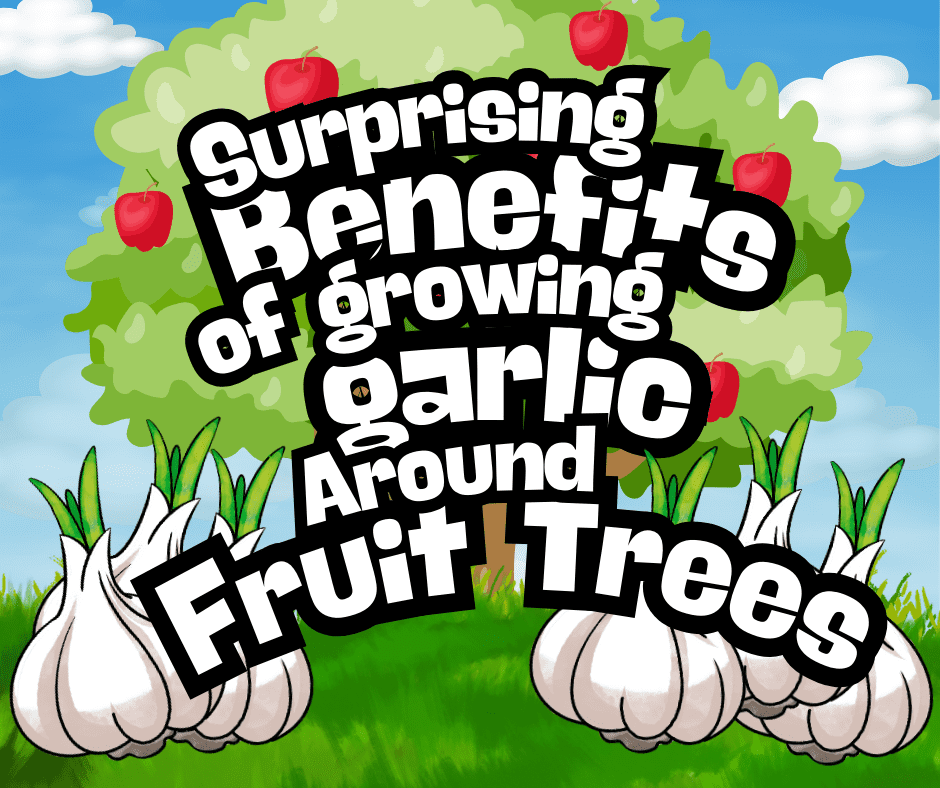
From boosting tree health and warding off pests to improving soil fertility and enhancing fruit flavor, the advantages of growing garlic in your fruit tree garden are numerous.
I will explore the various ways in which garlic can positively impact your fruit trees, providing you with invaluable insights and practical tips for successful cultivation.
This is a pinnable post. Tap or hover over any image in this post to pin to your Pinterest Boards.

Introduction to Growing Garlic Around Fruit Trees
Understanding the Benefits of Companion Planting
We all know that two is better than one, whether it’s Batman and Robin or peanut butter and jelly. The same concept applies to gardening, and that’s where companion planting comes in. Companion planting involves strategically pairing certain plants together to maximize their growth and health. One surprising pairing that works wonders is growing garlic around fruit trees. Yes, you heard that right – garlic and fruit trees can be a match made in horticultural heaven!
Why Garlic Is an Excellent Choice for Fruit Tree Gardens
Garlic isn’t just for warding off vampires; it also has fantastic benefits for your fruit trees. This pungent bulb is packed with nutrients and natural compounds that can boost the overall health of your fruit trees.
Plus, garlic is a low-maintenance plant that requires minimal effort to grow, making it an ideal choice for busy gardeners.
If you’re ready to start planting garlic around your fruit trees, it’s easy to get started with just a few essentials. I recommend using seed garlic like this one to ensure strong, chemical-free growth. Pair it with quality compost or organic soil to give your garlic a healthy head start, and don’t forget a good garden trowel for quick, precise planting.
For those of us who like to keep things tidy, a bundle of reusable plant markers is perfect for tracking what you’ve planted and where. As an Amazon Associate, I earn from qualifying purchases—thank you for supporting my garden while growing yours!
Boosting Fruit Tree Health with Garlic
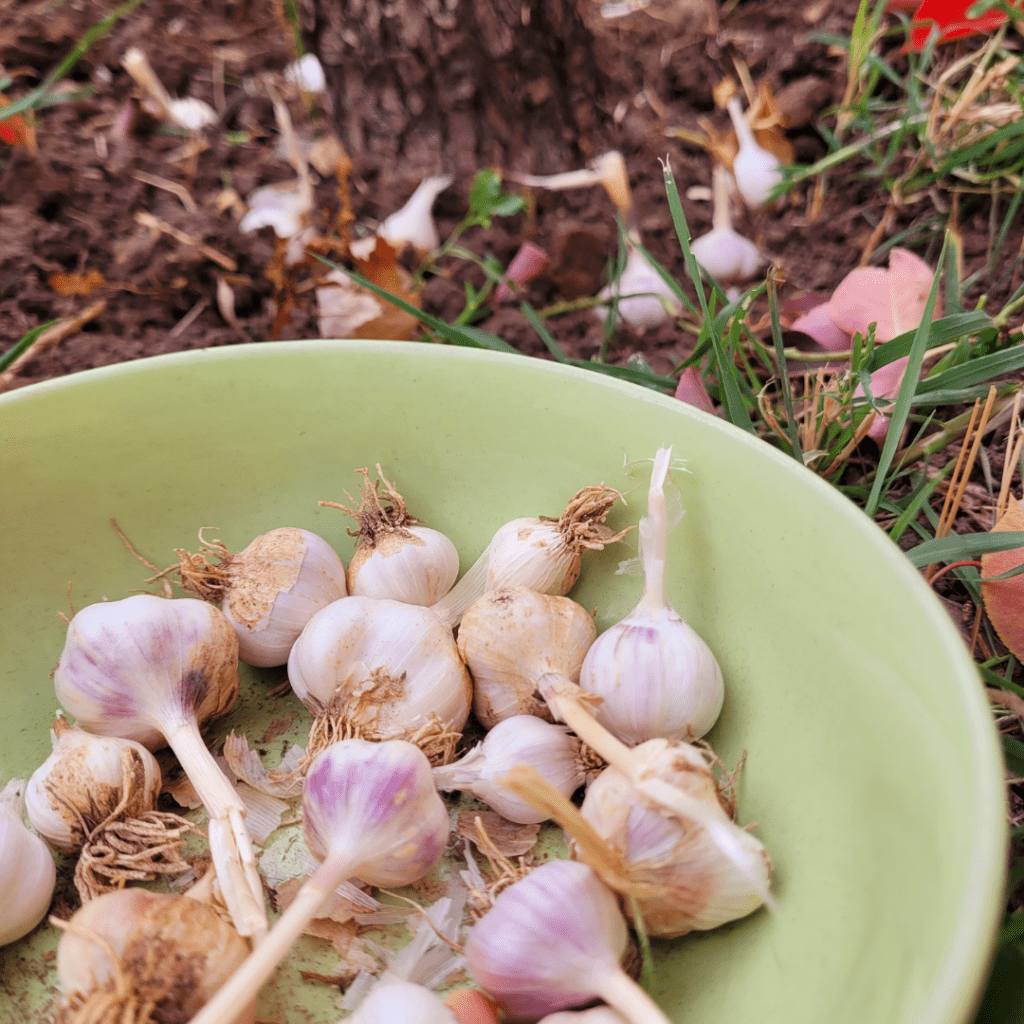
I separated the garlic heads into individual cloves and planted each clove in a circular ring at the drip lines of my fruit trees. Each year, they grow nice and thick under the fruit trees, repelling invasive insects that can damage the fruit that is developing in them. This helps me to grow organically as much as possible!
Since planting garlic under my fruit trees in my backyard, I no longer deal with worms in the cherries, and have seen less bug damage on my quince and pear trees. This is an effective and simple strategy to combat pests in my orchard in which I will be doing every year from now on.
Garlic’s Role in Improving Nutrient Uptake
Did you know that garlic can help your fruit trees become nutrient ninjas? That’s right! Garlic contains sulfur, which is essential for the formation of enzymes, proteins, and chlorophyll in plants. By growing garlic around your fruit trees, you’re providing them with an extra dose of sulfur, which can enhance their nutrient uptake and overall growth.
It’s a simple way to give your fruit trees a natural boost, helping them grow stronger and produce even more delicious fruit year after year.
To really maximize garlic’s impact on your fruit trees, consider giving your soil a little extra love. Adding organic sulfur amendments can complement what garlic provides naturally, ensuring your trees get the full nutrient boost they deserve. I also recommend using a simple soil test kit to check for nutrient levels, especially sulfur and pH, so you know exactly what your garden needs.
For a long-term boost, a fruit tree fertilizer enriched with micronutrients or a mycorrhizal root booster can enhance root absorption and work hand-in-hand with your garlic companions. These small additions can make a big difference in the health and productivity of your orchard.
Strengthening Fruit Tree Immunity and Resistance
Just like we take our daily multivitamins to keep our immune system in tip-top shape, garlic can do the same for your fruit trees. Garlic has natural antifungal and antibacterial properties that can help prevent diseases and infections in your precious fruit trees.
By growing garlic as a companion plant, you’re giving your fruit trees an added layer of defense against pests and pathogens.
To strengthen your fruit trees’ natural immunity even further, consider combining garlic with other natural plant protectors. A spray like neem oil adds an extra antifungal and insect-repelling layer that works beautifully alongside your garlic companion planting. You can also try a garlic-based garden spray for broader pest deterrence throughout your orchard. If you’re dealing with persistent threats, a copper fungicide or seaweed-based foliar spray can help reinforce your trees’ defenses from the inside out.
Tree wraps keep pests from damaging vulnerable bark and provide added protection at the base. These simple tools work hand-in-hand with garlic to help your fruit trees thrive, strong, resilient, and ready for a fruitful season.
Natural Pest Control with Garlic
Repelling Common Fruit Tree Pests with Garlic
Are pesky pests bothering your fruit trees? Don’t worry, garlic is here to save the day! Garlic’s strong aroma is a natural deterrent for many common fruit tree pests such as aphids, caterpillars, and mites.
Simply planting garlic around your fruit trees can help keep these unwanted visitors at bay. Say goodbye to chemical pesticides and hello to a garlic-powered pest control plan that will leave your fruit trees happy and pest-free.
I have been asked many times since writing this post and pinning it to Pinterest if the fruit will develop a garlic flavor. I can assure you that growing garlic around your fruit trees will not affect the flavor of the fruit. In fact, it helps make them tastier!
Garlic Spray Recipe for Pest Management
If planting garlic alone isn’t enough to ward off those persistent pests, you can also create your own garlic spray. Simply blend some garlic cloves with water, strain the mixture, and voila – you’ve got yourself a homemade garlic pest control potion!
Spray this mix onto your fruit trees, and watch those pests scurry away in annoyance. It’s a win-win situation – your fruit trees stay healthy, and pests are kept at a safe distance. Who knew garlic could be the hero your garden needs?
Improving Soil Fertility and Structure
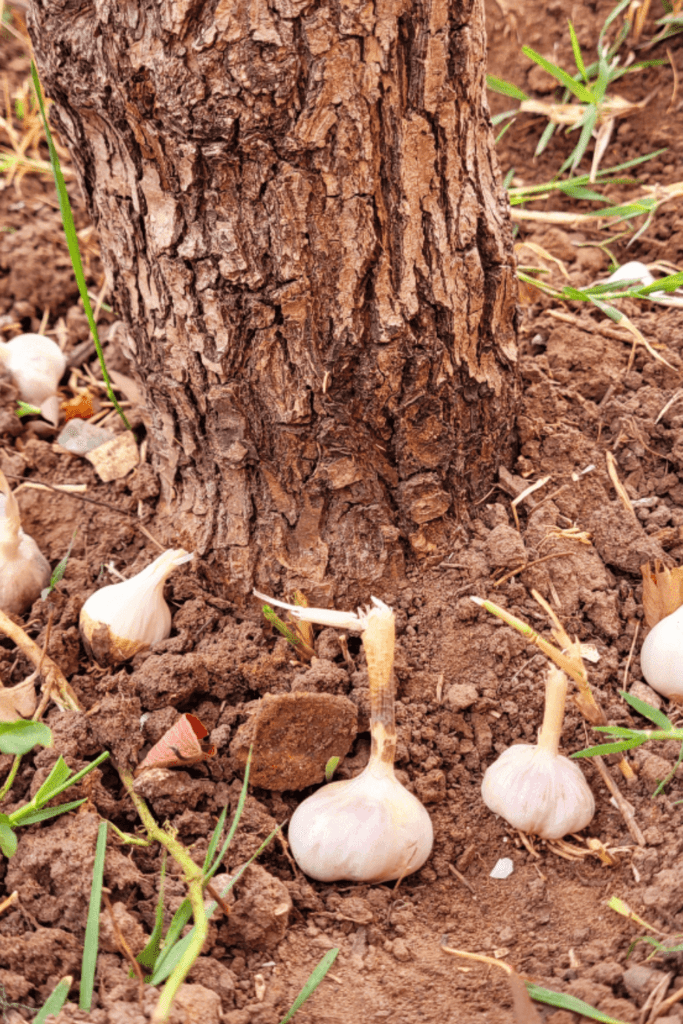
How Garlic Contributes to Soil Health
Garlic not only has benefits for your fruit trees but also for the soil they grow in. When garlic plants decompose, they leave behind organic matter that enriches the soil with nutrients. This organic matter helps improve soil fertility, making it more conducive for the growth of your fruit trees.
Additionally, garlic’s long roots help break up compacted soil, enhancing its structure and allowing better water and nutrient penetration.
I grow my harvesting garlic in separate beds for our food consumption, so I will allow my garlic to reseed itself every year without much effort on my part. For the past three years, the garlic around my fruit trees has been coming back thicker each season! I explain more in the following sections.
Using Garlic as a Natural Soil Amendment
Instead of reaching for chemical fertilizers, why not harness the power of garlic to amend your soil naturally? By incorporating garlic into your compost or using it as a mulch, you can improve soil structure and increase its fertility.
The added benefits of garlic’s pest-repelling properties and nutrient-rich decomposition make it a fantastic all-around soil amendment. Your fruit trees will thank you for the garlic-infused soil feast, and you’ll have a thriving garden with minimal effort.
Enhancing Fruit Flavor Through Companion Planting
Garlic’s Impact on Fruit Taste and Aroma
We all want our fruit trees to produce mouthwatering fruits that burst with flavor. Well, here’s a surprising secret: garlic can help with that! When you grow garlic around your fruit trees, its pungent compounds can actually enhance the taste and aroma of the fruit. So not only will your apples be crisp and juicy, but they’ll also have an extra zing of garlic-induced deliciousness.

Over the years, I have expanded the garlic patch to reach the drip line of the fruit trees. In the early years, I had only had the garlic patch around the base of the fruit trees, and have since expanded it. This helps the fruit trees in numerous ways by repelling pests, and I have never had worms in my cherry or pears since doing this!
Complementary Herbs and Vegetables for Improved Fruit Flavors
Planting the right herbs and vegetables near your fruit trees can do more than just save space—it can actually enhance the flavor of your harvest. Certain companion plants like basil, chives, or even strawberries can help improve pollination, deter pests, and subtly influence the taste of your fruit by creating a more balanced micro-ecosystem.
It’s one of those old-fashioned garden secrets that modern growers are rediscovering: when your plants work together, everything tastes better!
Garlic’s Role in Suppressing Diseases in Fruit Trees
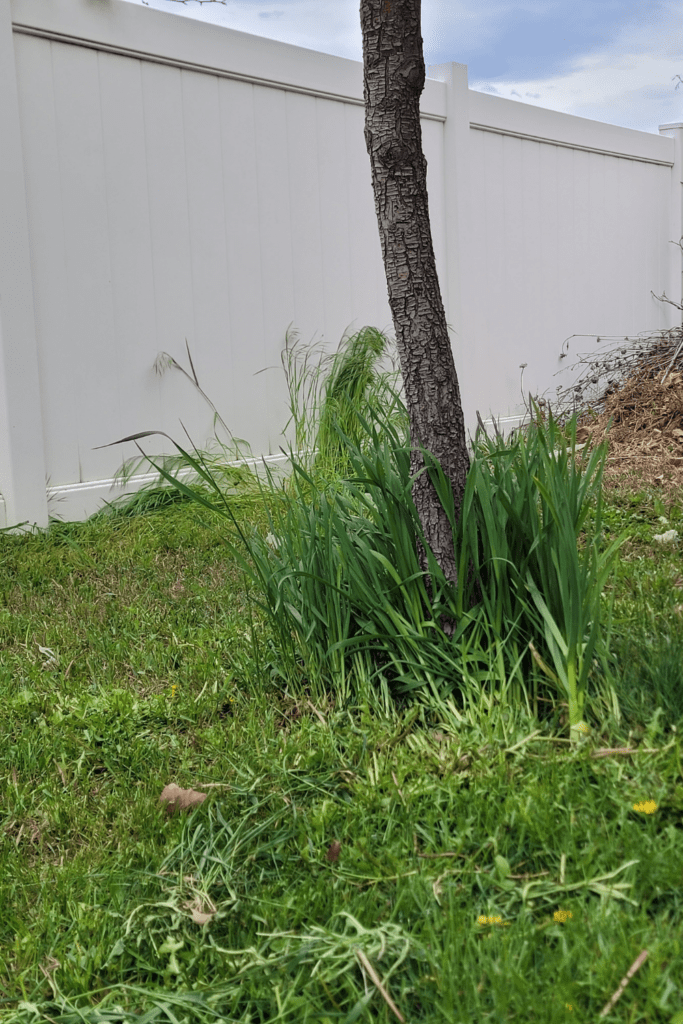
…and if you’re building a backyard orchard, my book Harvesting Paradise is a helpful companion.
Preventing Fungal Infections with Garlic
When planted around your fruit trees, garlic releases natural antifungal compounds into the soil that help protect roots from rot and common fungal infections. Its strong scent also helps keep moisture-loving pests at bay, reducing the risk of disease spreading through your orchard.
It’s an easy, chemical-free way to keep your trees healthier, especially in damp or humid conditions where fungus thrives.
Garlic’s Antibacterial Properties for Disease Control
But wait, there’s more! Garlic doesn’t just scare off fungi; it also has antibacterial powers that can help control diseases in your fruit trees. Garlic contains compounds that can inhibit the growth of harmful bacteria, keeping your trees healthy and happy.
So, while your fruit trees may be surrounded by garlic, they’ll be safe from bacterial trouble.
How to Plant Garlic Around Fruit Trees
In this video, I show how I plant garlic and walking onions in my orchard around each of my fruit trees for effective pest management.
Planting garlic around your fruit trees is simple, low-maintenance, and one of the easiest ways to boost your orchard’s health. Here’s how I do it on my own homestead each fall.
1. Choose the Right Garlic
You can use:
- Hardneck garlic (great for cold climates like northern Utah)
- Softneck garlic (good if you want longer-lasting braids)
Break the bulbs apart just before planting so each clove is fresh and firm.
2. Plant in Fall
Garlic does best when planted in late fall, usually after your first light frost but before the ground freezes solid.
This gives the cloves time to root and get established before winter.
3. Space Your Cloves Around the Tree
Plant the garlic:
- 8–12 inches from the trunk
- In a circle or loose ring around the tree
- Spacing each clove 4–6 inches apart
This keeps the garlic close enough to deter pests and improve soil health, but far enough not to disturb the roots of young trees.
4. Planting Depth
Place each clove with the pointy end up and cover with:
- 2 inches of soil, then
- 2–3 inches of mulch (leaves, wood chips, straw — whatever you have)
The mulch protects the cloves over winter and helps retain moisture in spring.
5. Water Lightly
You don’t need much water.
Just give the area a light watering after planting to settle the soil. After that, fall and winter moisture will take care of the rest.
6. Let It Grow
Once spring arrives, you’ll see garlic shoots pop up all around your tree.
They don’t compete with the tree — they actually help reduce weeds and may deter pests like aphids and borers.
I have a more indepth guide on how to plant garlic in my other post, How to Grow Garlic and Know the Signs of When to Harvest.
Harvesting and Using Garlic In the Garden
When and How to Harvest Garlic
When the time comes to harvest your garlic, you’ll know it’s ready when the leaves start to turn yellow and dry out. Gently dig around the bulbs with a garden fork, being careful not to damage them.
Once you’ve dug them up, let them cure in a cool, dry place for a couple of weeks. And voila, you’ll have fresh garlic ready to use in your kitchen!
Delicious Recipes Using Freshly Harvested Garlic
Now that you have a stash of freshly harvested garlic, it’s time to put it to good use in some mouthwatering recipes. From garlic-infused pasta sauces to roasted garlic mashed potatoes and even garlic butter for your toast, the possibilities are endless.
Get creative, experiment with flavors, and savor the incredible taste of homegrown garlic.
Tips and Considerations for Successful Garlic Cultivation with Fruit Trees
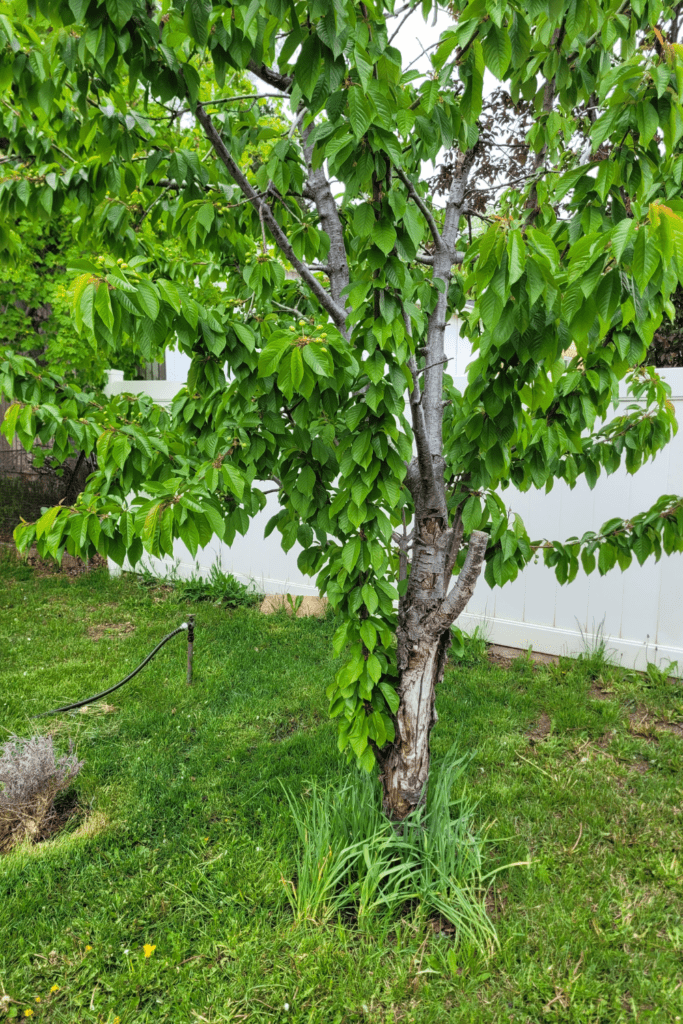
Choosing the Right Garlic Varieties for Companion Planting
Not all garlic is created equal when it comes to companion planting. Hardneck varieties, like Rocambole or Purple Stripe, tend to have a stronger aroma that can better deter pests, while softneck types such as Silverskin are more adaptable to warmer climates and offer a longer shelf life.
The key is to choose a variety that suits your growing zone and garden goals. Whether you’re after pest protection, improved soil health, or a flavorful harvest, the right garlic variety can make all the difference in your orchard’s overall success.
Optimal Planting Methods and Spacing for Garlic
To ensure successful garlic cultivation, it’s essential to plant them correctly. Garlic prefers well-drained soil, so make sure to prepare the planting area accordingly. Plant individual cloves about 2 inches deep and space them around 6 inches apart.
This gives each garlic bulb enough room to develop and grow into a flavor-packed delight. Remember, well-spaced and happy garlic bulbs lead to happy fruit trees!
Garlic’s Benefits Go Beyond the Garden
While garlic is an incredible companion plant for fruit trees, its power doesn’t stop in the orchard. Garlic is also one of the most effective natural remedies for supporting health and wellness, from boosting immunity to protecting heart health. If you’d like to learn more about using garlic for your own well-being, check out my post: Powerful Health Benefits of Garlic and Its Effects.
Using Garlic as a Natural Pest Deterrent in Your Orchard
So again, one of my favorite orchard hacks is planting garlic around my fruit trees to naturally keep pests away. Since I started this method, I haven’t had a single worm in my cherries or pears! The strong aroma of garlic deters many common pests, creating a protective barrier around my trees. While growing garlic under trees isn’t always considered ideal due to shade and competition for nutrients, I’ve still managed to harvest full-size garlic heads. I also maintain a separate garlic bed for harvesting, but the primary purpose of the garlic planted under my fruit trees is pest control. It’s an easy, natural, and effective way to keep your orchard healthy without relying on chemicals.
Ready to Take Your Orchard to the Next Level?
If you’re excited about growing garlic around your fruit trees, you’re going to love the deeper companion planting strategies I’ve packed into my book Harvesting Paradise: Your Guide to Growing a Backyard Orchard.
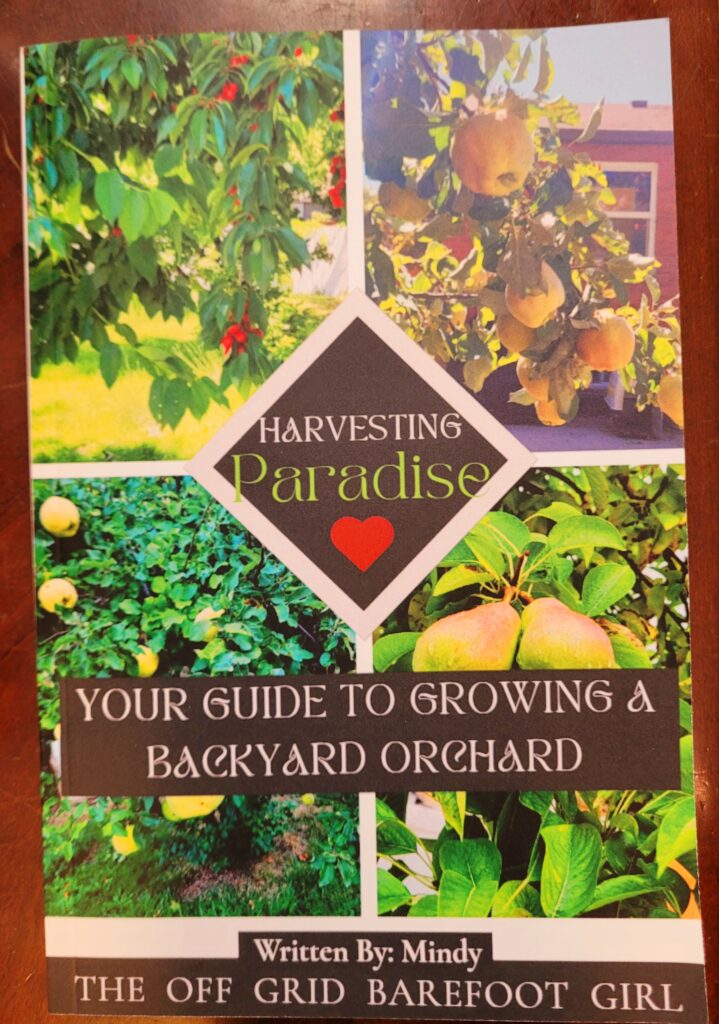
This isn’t just a general gardening book — it’s a down-to-earth, practical guide filled with step-by-step tips I use right here in my own backyard orchard. From choosing the best garlic varieties to pair with your trees, to mapping out a productive, resilient layout for your entire backyard orchard, I wrote it to be the kind of book I wish I had when I was getting started.
Inside, you’ll learn:
- Simple steps to choose, plant, and care for fruit trees
- Seasonal orchard planning worksheets
- Garden & pantry prep checklists
- Space to write, plan, and track your orchard journey
- 🧺 Bonus: Fruit Tree Canning Recipes
- You didn’t think I’d let all that fruit go to waste, did you? Inside you’ll find my favorite canning recipes, including:
- 🍂 Fall Spiced Quince Chutney 🍐
- 🍯 Canned Quince 🍐
- 🍒 Canning Whole Cherries
- 🥧 Cherry Pie Filling Recipe
- 🍒 Cherry Syrup Recipe
- 🍐 Pear Pie Filling Recipe
Whether you’re just planting your first tree or already knee-deep in orchard life, this book will help you grow more food with less waste — and a lot more joy!
👉 Click here to get Harvesting Paradise on Etsy
👉 Or buy it on Amazon
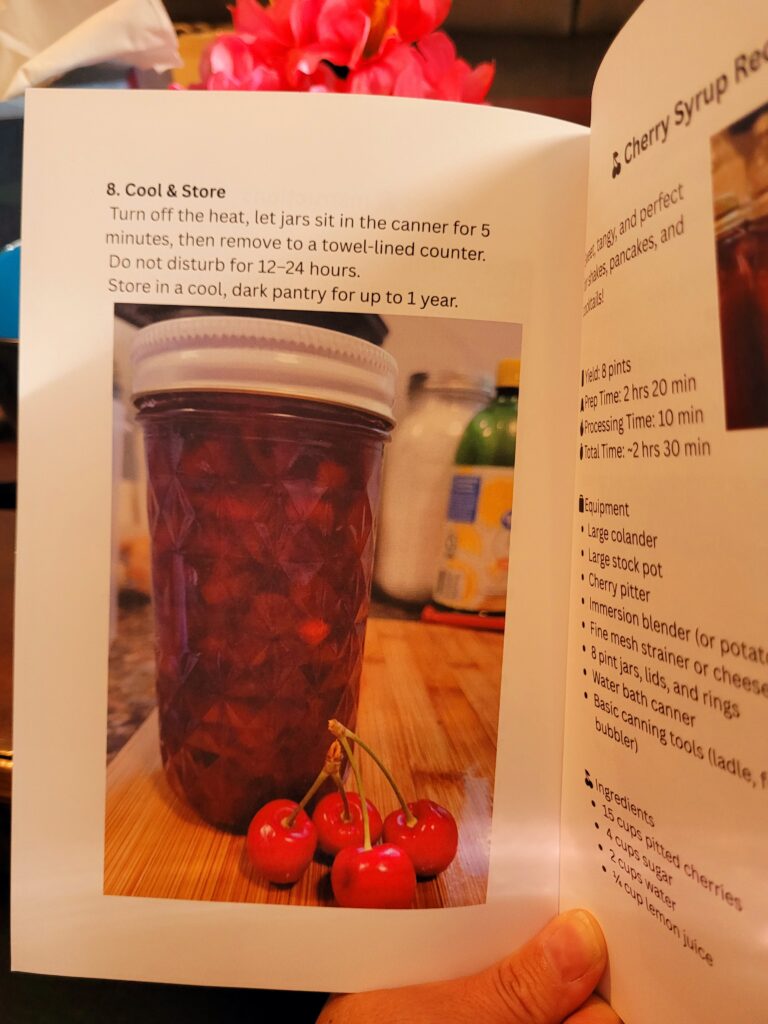
Conclusion
In conclusion, growing garlic around your fruit trees can bring about a multitude of benefits that extend far beyond its delicious taste and culinary uses. By acting as a natural pest deterrent, promoting tree health, enriching the soil, suppressing diseases, and enhancing fruit flavor, garlic proves to be an invaluable companion for your fruit tree garden.
So, why not harness the power of garlic and unlock the extraordinary potential it holds for your fruit trees? Start incorporating garlic into your garden today and reap the surprising rewards that await.
Resources: Here are some helpful resources for further information.
- Planning My Backyard Orchard – By Growing Fruit
- Planning the Homestead Orchard – By Homestead.org
- Enjoy Backyard Orchard Culture – By The Giving Grove
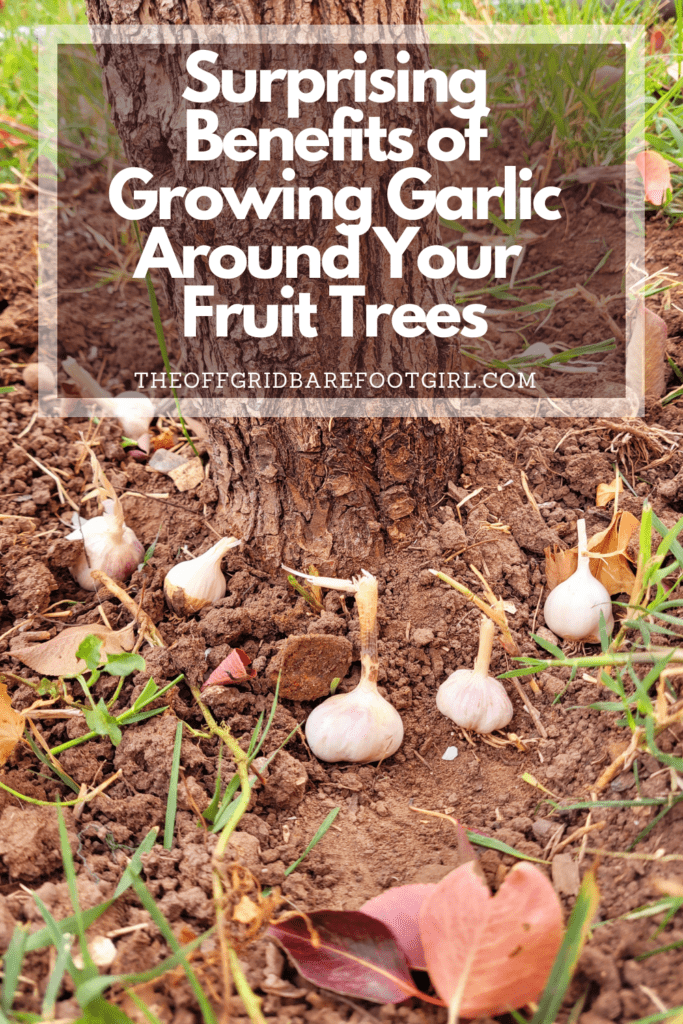
Frequently Asked Questions
1. Can I plant garlic directly next to my fruit trees?
Absolutely! Planting garlic directly next to your fruit trees is a fantastic way to maximize its benefits. The strong aroma of garlic can help repel pests and create a natural barrier around your trees. Just make sure to provide enough spacing between the garlic bulbs and the tree trunk to prevent competition for nutrients and water.
2. How often should I apply garlic spray for pest control?
It is recommended to apply garlic spray for pest control once every one to two weeks, especially during periods of high pest activity or infestation. Be sure to follow the instructions on the spray recipe and apply it evenly on the leaves and branches of your fruit trees.
3. Can I use store-bought garlic for companion planting with fruit trees?
While store-bought garlic can still provide some benefits when planted with fruit trees, it is recommended to use organic, heirloom, or locally sourced garlic if possible. These varieties often contain higher levels of natural compounds that contribute to the beneficial properties of garlic in companion planting.
4. When is the best time to harvest garlic for culinary use?
The ideal time to harvest garlic for culinary use is when the leaves have started to turn brown and dry out, typically in mid to late summer. Carefully dig up the bulbs, making sure to leave the stalks intact. Hang the harvested garlic in a cool, dry place to cure for a few weeks before using it in your favorite recipes.
See What Others Are Saying on Pinterest!
Summary
I hope I have inspired you to grow garlic with your fruit trees.
If you were encouraged by this post, I invite you to check out my FREE Printables Page for fun free printables, planners, and charts.
ENTER MY FREE Printables Page HERE
I invite you to check out some more of my posts!
Why You Need to Start Micro-Orcharding in Your Backyard
Strawberries: How to Grow a Productive Perennial Strawberry Patch
Raspberries: How to Grow a Productive Perennial Raspberry Patch
Quince Trees: All About Quince Trees: Ultimate Guide
Cherry Trees: All About Cherry Trees: Ultimate Guide
Pear Trees: All About Pear Trees: Ultimate Guide
Vegetables: Square Foot Garden: The Easy Way to Plan Yours.
Blessings,
The Off Grid Barefoot Girl



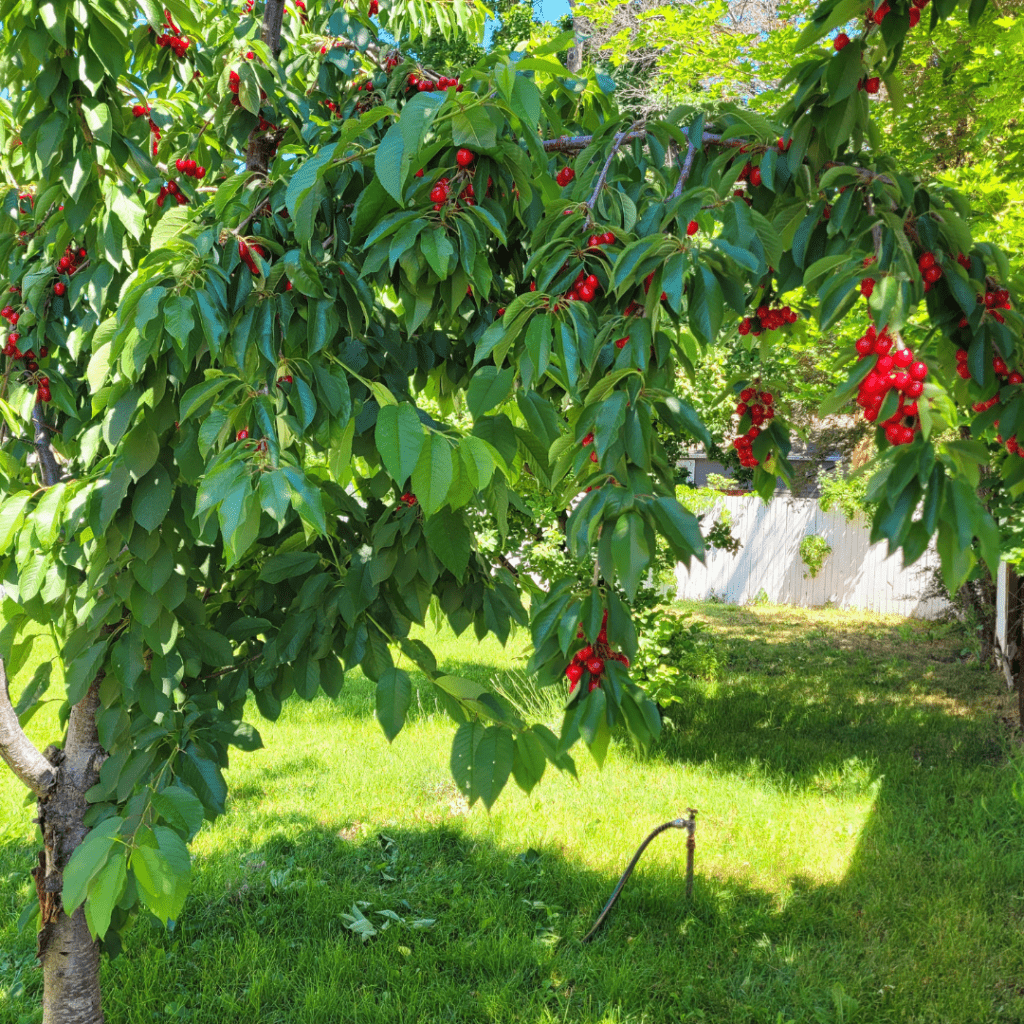
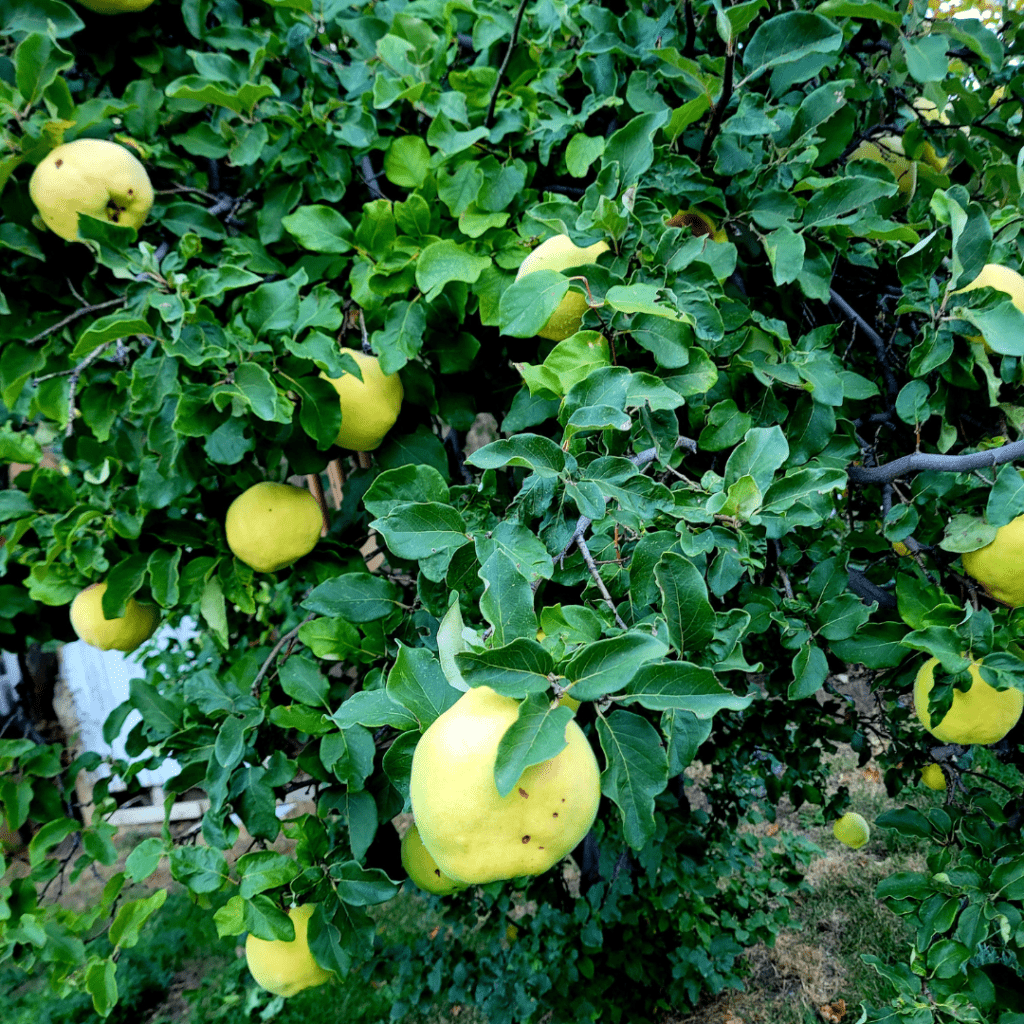
You mention garlic around cherry and pear trees but what about other fruit trees? Does is repel pests around apples, figs or peaches? What about berry bushes and vines? Do I have to use it for more than one fruiting season for it to become effective or does it start repelling the from the first planting? I find this very interesting.
Hi Theresa. I started growing garlic around my orchard in 2023.I mention growing garlic around the plants that I currently grow. I am sure it will work with any fruit tree or berry bush. It also works with vegetables. I wrote this post after discovering that I no longer have earwigs or worms in my fruit. I noticed it worked on the very first season that I tried this. The garlic around my trees is grown for pest control. Garlic can be a perennial if you do not harvest it, meaning it will always come back the following year. I have a separate garlic bed for consumption. The garlic in my orchard, I do separate and replant or spread out. I never had to rebuy garlic for this project. I will dig up the garlic in July and lay them out in the shed until fall and put them right back in the orchard. Or I will cut the foliage down to ground level and allow the garlic bulbs in the ground to multiply on their own. It really depends on how I feel. Give it a try! It will work on the first season! Plant some garlic in the fall in your orchard and see by spring and summer that you will experience less pests. If you have anymore questions, you can always ask!
Happy I found your post. Recently our land and especially our fruit trees have been invaded by ground squirrels, and they love to dig nests under the fruit trees. I had the idea this fall to plant garlic under the trees to perhaps make the trees less attractive to these creatures. Good to see there is also a nutrient benefit. Next summer I will see if the garlic helps reduce ground squirrels as well, or perhaps delights them!
Hi! I read that garlic repels squirrels so definitely give this idea a try! Sorry to hear about them digging nests under your fruit trees. I really hope this helps!